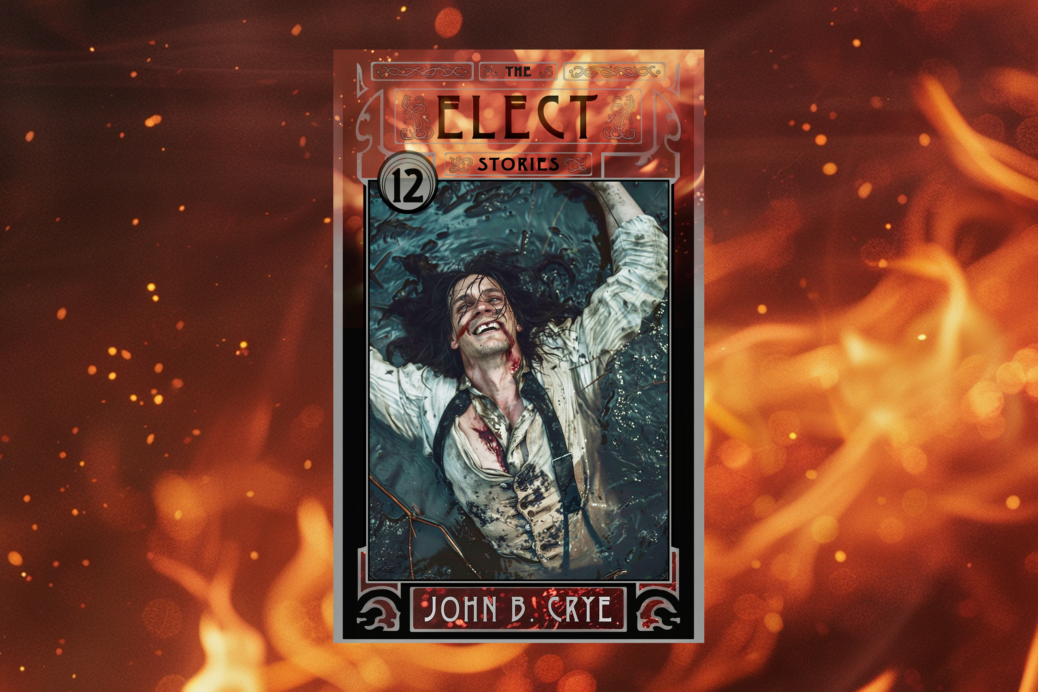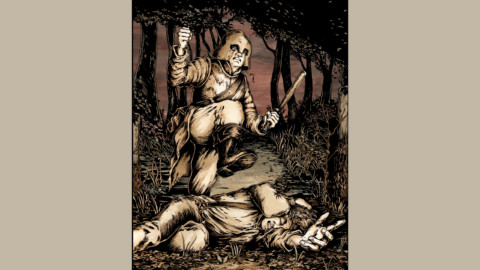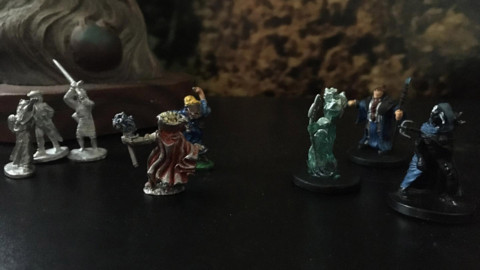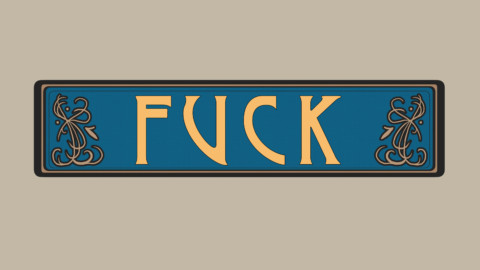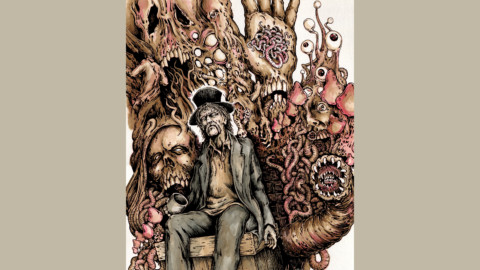A friend of mine who has diligently purchased every installment of “The Elect Stories” upon its release recently made a confession: he hasn’t actually started reading them yet, but he enjoys collecting them. Fair enough. You don’t even have to open them to see that Todd’s covers are super cool, and who doesn’t love a groovy little stack of paperbacks to fill out a reading shelf, or to strew tantalizingly on a coffee table, or to tuck neatly on the back of a toilet? Collect away, I won’t judge. Then my friend clarified that’s he’s waiting until all twelve are released and the story is complete so he can binge read his way through the whole thing. This is also totally understandable. While the story was released episodically to evoke the joy of cliffhanger serials and penny dreadfuls, I also know the pleasure of settling in for the weekend with a four hundred-plus page tome and gorging my head. I get it. If you prefer the latter to the former, then I am pleased to say, my friend, your time has come. With the release of The Elect Stories #12: “Declaration, or, The Closing of the Circle,” this volume is complete.
“But wait!” you say. “I saw on the official website that the story is thirty-six chapters in total, not twelve! Should I read once the first twelve are released or wait for thirty-six?” It is true that “The Elect Stories” is functionally a trilogy, in which these twelve chapters form the first book. The three books do tell a continuous story, of course, but it is my hope that each is a satisfying read on its own. I believe that a big part of a read being satisfying is a strong climax. I think this one sticks the landing. Hope you agree.
Admittedly, writing a trilogy was not my original intention. As I laid out the structure for the story, however, it became clear that there was simply too much to squeeze into a single book. I didn’t want to arbitrarily chop the material into thirds – a choice that didn’t exactly ruin Tolkien’s magnum opus, but c’mon, I ain’t foolin’ myself here – so I tore the whole thing apart and rebuilt it with the structure that you can now read: three volumes of twelve chapters apiece. This broke the story into more manageable pieces, and it has allowed us to pursue this fun “chapter book” publishing experiment, but more importantly, the new structure has yielded a richer storytelling experience for me and, hopefully, a more enjoyable reading experience for you.
Structure has always been my thing. Since 1998 or so, it has been my thing professionally. That’s when I started working at Newmarket Entertainment where I had the opportunity to work on the development of a number of independent features, including two of Christopher Nolan’s earliest mind-benders, “Memento” and “The Prestige.” What fascinated me about both of those films is that they are decidedly non-linear while still maintaining a standard story structure. That is, despite the scenes being delivered out of chronological order, the sequence of the dramatic “beats” that drive the story remains intact. There is still an establishment of a status quo, introductions of characters and themes, an inciting incident that sets the story in motion, et cetera. These essential story elements are still delivered in that same age-old order that’s been celebrated by teachers of story structure from Aristotle to Blake Snyder, but the scenes chosen to satisfy the dramatic criteria of those elements are otherwise out of their usual sequence. That gives some folks a headache but, to me, that’s friggin’ fun. It was around the time of working on those films that I first started to codify my ideas about story structure, and to create efficient practices for creative development that I still use today with the clients of my consultancy, True Development. While those concepts and practices were created for screenwriting, I have also employed them on the development of “The Elect Stories.” Once I made the decision to break the story up into multiple volumes, I started using these methods to create a “fractal story structure,” in which every part of the story from scene to chapter to book to trilogy is built with the same structure as the whole. First, for those who aren’t story wonks, a few words on the basics of structure:
In brief, a story’s structure can be broken down into “acts.” Typically, stories are broken into three acts, but some writers will use four or five acts for a more detailed approach. These acts can further be broken down into scenes. These scenes contain actions and dialogue that relate the story as a sequence of events. Interestingly, whether that story is dramatic or funny or horrifying, the chain of cause and effect seen in the sequence of events is, in the most basic sense, the same: The protagonist experiences something that changes their status quo. After some debate, they take action in response. They struggle to restore the old status quo, to create a new one, or to gain something from the change. Ultimately they succeed or fail based on how well they learned and adapted along the way. This doesn’t apply to every story, but start looking at some of your favorite movies and books through this lens and you’ll find that most stories do share the basics of this structure. That’s not an arbitrary thing, nor is it a symptom of Hollywood’s laziness. It is a pattern of cause and effect that is recognized and appreciated by the human brain. If you want a human to comprehend your story and find it believable / satisfying, eons of trial and error from holy men, bards, griots, novelists, journalists and raconteurs have discovered that this structure works. Now, I don’t recommend creating a story simply by filling in those blanks “Mad Libs”-style. That’s just a more efficient way to generate uninspired content. Instead, use the structure to test a story that you feel is lacking some unidentified element. Try to match elements of your story to each of the beats and you will quickly discover what is missing or out of sequence. I’ve been doing this for over 20 years, and every time a writer engages in this simple practice, they inevitably realize that the missing beat identified is a scene or moment that they’ve been struggling with already. The most efficient way to fix a scene like that is to ask what purpose it serves in the story’s overall structure. Okay, now that we understand the importance of story structure, but what’s a “fractal story structure”? Read on.
A fractal is a pattern in which every part at every scale is self-similar, like a cube made up of smaller cubes. Fractals can be seen in nature in the branching of tree limbs, or the geometric patterns of snowflakes and crystals. In a fractal story structure, the plot’s chain of cause and effect can be broken out into multiple acts, and each act will also reflect that same chain of cause and effect, as will each scene. If a three act story can be simply described as “set-up, challenge, and result,” a fractal story structure will then describe each separate act as having its own set-up, challenge, and result, and each scene within each act will likewise have its own set-up, challenge, and result. “The Elect Stories” is a tale told in three volumes, with each volume serving as an act. Each volume is then broken down into its own three-act structure, with four chapters per act. Each of those chapters also has its own three-act structure made up of scenes. Make sense?
This is a very long and nerdy way of answering my reader’s original question, “Should I start reading now or wait?” In short, for those who were waiting until they could binge a complete story, you may begin now. While these twelve chapters serve as the first act of a larger tale, they form a complete story unto themselves. Or, at least, that is my intention. I invite you to give ‘em a read and tell me if you agree.
